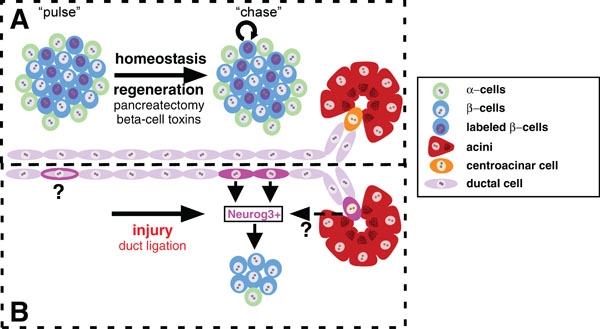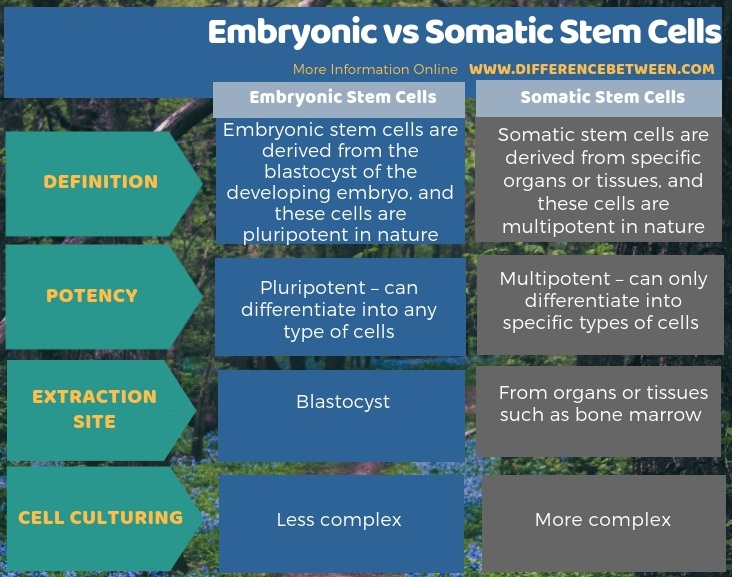Difference Between Embryonic and Somatic Stem Cells
Table of Contents
The key difference between embryonic and somatic stem cells is that the embryonic stem cells are pluripotent undifferentiated cells that have embryonic origin while somatic stem cells are multipotent undifferentiated cells that are of tissue and organ origin.
Stem cells are undifferentiated cells which are capable of growing into true tissues or organs. Generally, there are two major stem cell types as embryonic stem cells and adult stem cells (somatic stem cells). In the case of differentiation, embryonic stem cells can differentiate into any type of cells. In contrast, somatic stem cells can only differentiate into several tissue-specific cells. Therefore, embryonic stem cells are pluripotent while somatic stem cells are multipotent. In simple words, the ability of differentiation is high in embryonic stem cells in comparison to that of somatic stem cells.
CONTENTS
1. Overview and Key Difference
2. What are Embryonic Stem Cells
3. What are Somatic Stem Cells
4. Similarities Between Embryonic and Somatic Stem Cells
5. Side by Side Comparison – Embryonic vs Somatic Stem Cells in Tabular Form
6. Summary
What are Embryonic Stem Cells?
Embryonic stem cells are a type of undifferentiated cells present in early stages of embryonic development. The inner cell mass of the blastocyst is made up of embryonic stem cells. These embryonic stem cells are pluripotent in nature. Thus, they can differentiate into any type of cells. The extraction of embryonic stem cells can be done from the blastocyst stage of the embryonic development for stem cell culture. Following the extraction, the cells undergo maturation and division under in vitro conditions. The embryonic stem cells are able to grow in special high nutrient media where they differentiate into the three germ layers: ectoderm, endoderm, and mesoderm.

Figure 01: Embryonic Stem Cells
In modern therapy, embryonic stem cells are valuable tools in regenerative therapy and tissue replacement following injury or disease. The diseases that use embryonic stem cell therapy at present are diabetes, neurodegenerative disorders, spinal cord, and muscular injuries.
What are Somatic Stem Cells?
Somatic stem cells are the stem cells present in specific tissues and organs in adults. Therefore, ‘adult stem cells’ is a synonym of somatic stem cells. Thus, adult stem cells originate from mature tissues and organs. They are multipotent cells; this means they can differentiate into several types of cells, but not pluripotent like embryonic stem cells. There are different types of somatic stem cells such as hematopoietic stem cells, intestinal stem cells, endothelial stem cells, neuronal stem cells, and mesenchymal stem cells.

Figure 02: Somatic Stem Cells
During division, somatic stem cells undergo two pathways. They are symmetric division and asymmetric division. The symmetric division produces daughter cells of similar properties whereas asymmetric division produces one similar daughter cell and a different progenitor cell.
There are many uses of somatic stem cells in research. They are useful in many drug testing protocols to check the effects of particular drugs or metabolites. Moreover, somatic stem cells are useful to determine the cellular behavior of particular organs and their signaling pathways. Furthermore, scientists use somatic cells as therapy as they are able to regenerate cells when proper conditions are present.
What are the Similarities Between Embryonic and Somatic Stem Cells?
- Embryonic and somatic stem cells are undifferentiated cells that have the potency to differentiate into different cell types.
- Both are regenerative.
- Moreover, they can be proliferated artificially in in vitro
- These cells require high nutrient media for optimal growth.
- Most importantly, scientists use both types of cells in therapy and scientific research.
What is the Difference Between Embryonic and Somatic Stem Cells?
The key difference between embryonic and somatic stem cells is their site of extraction. Blastocyst stage of the embryonic development is the site of extraction of embryonic stem cells while specific tissues are the sites of extraction of somatic stem cell. Especially, embryonic stem cells can differentiate into any type of cells. In contrast, somatic stem cells cannot differentiate into all types of cells and can only differentiate into specific types of cells based on their origin. Therefore, this is also a major difference between embryonic and somatic stem cells.
Another difference between embryonic and somatic stem cells is their cell culturing process. Cell culturing of somatic stem cells are more laborious in comparison to embryonic stem cell culture.
The below infographic presents more information on the difference between embryonic and somatic stem cells.

Summary – Embryonic vs Somatic Stem Cells
Stem cells are undifferentiated cells. There are two broad classes of stem cells as embryonic stem cells and somatic stem cells. In summarizing the difference between embryonic and somatic stem cells, the embryonic stem cells can differentiate into any type of cells; thus, they are pluripotent. In contrast, somatic stem cells or adult stem cells can differentiate only into specific types of cells; thus, they are multipotent. Above all, the key difference between embryonic and somatic stem cells is the site of the derivation of these cell types. Embryonic stem cells are derived from the blastocyst while somatic stem cells are derived from specific organs upon the requirement.
Reference:
1. Henningson, Carl T, et al. “28. Embryonic and Adult Stem Cell Therapy.” The Journal of Allergy and Clinical Immunology, U.S. National Library of Medicine, Feb. 2003, www.ncbi.nlm.nih.gov/pubmed/12592319.
Image Courtesy:
1. “Human embryonic stem cells only A” Автор: Human_embryonic_stem_cells.png: (Images: Nissim Benvenisty)derivative work: Vojtech.dostal (talk) – Human_embryonic_stem_cells.png (CC BY 2.5) via Commons Wikimedia
2. “Sources of new adult β-cells” By Murtaugh, L.C. and Kopinke, D., Pancreatic stem cells (July 11, 2008), StemBook, ed. The Stem Cell Research Community, StemBook, doi/10.3824/stembook.1.3.1, http://www.stembook.org. – (CC BY 3.0) via Commons Wikimedia
ncG1vNJzZmivp6x7pbXFn5yrnZ6YsqOx07CcnqZemLyue8OinZ%2Bdopq7pLGMm5ytr5Wau26xzJupsqeenrBurc2dZKynnZbBqq%2BMrKuepV2Ysq240mg%3D